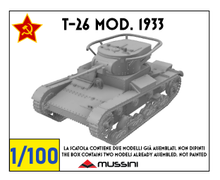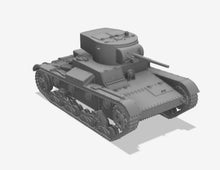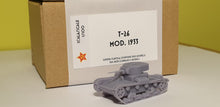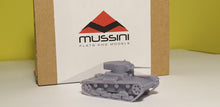Il T-26, nelle sue innumerevoli varianti, fu il carro armato costruito nel maggior numero di esemplari negli anni precedenti il secondo conflitto mondiale. Ne furono prodotti ben 12mila, che vennero impiegati principalmente dai reparti corazzati sovietici, anche se il loro battesimo del fuoco avvenne con le insegne della Spagna repubblicana, durante la guerra civile che infuriò tra il 1936 e il '39. Circa 500 T-26 vennero spediti da Mosca in terra iberica, dove si confrontarono con i ben più leggeri, e modestamente armati, Panzer I tedeschi e L3 italiani. La versione qui riprodotta in scala 1/100, il modello 1933, fu quella maggiormente utilizzata in azioni belliche. Il T-26, come il polacco 7TP, derivava strettamente dal carro leggero Vickers Six-ton, di cui l'Urss aveva ottenuto la licenza di produzione. Ne venne subito modificata la torretta, che venne ridisegnata ex-novo per ospitare un pezzo anticarro da 45 mm, giudicando l'armamento originale non sufficiente. Accanto ai ben più performanti BT-7, i T-26 formarono l'ossatura delle formazioni corazzate dell'Armata Rossa fino allo scoppio della guerra con la Germania e vennero impiegati in larga misura sia durante i brevi confronti bellici con i giapponesi del 1939, sia durante la guerra con la Finlandia, dove i mezzi palesarono molti difetti, fra cui una scarsa affidabilità.
In ogni confezione Mussini ci sono 2 T-26 modello 1933 in scala 1/100. Ogni modello è lungo 4,8 cm, largo 2,4 e alto 2,4.
Prodotto non adatto a minori di 14 anni. Pitture, colle e altri materiali non sono inclusi nella confezione. Alcune parti potrebbero essere piccole o con sporgenze affilate.
Note
L'articolo viene venduto NON dipinto.
E' possibile ordinare l'oggetto dipinto previa richiesta informazioni all'indirizzo info@mussinisas.it.
The T-26, in its various variants, was the tank built in the largest number in the years preceding the Second World War. As many as twelve-thousand were produced, which were mainly used by Soviet armoured units, even if their baptism of fire took place with the insignia of republican Spain, during the civil war that raged between 1936 and '39. About 500 T-26s were shipped from Moscow to Spain, where they faced the much lighter, and modestly armed, German Panzer I and Italian L3. The version reproduced here in 1/100 scale, the 1933 model, was the mostly used in war actions. The T-26, like the Polish 7TP, was strictly derived from the Vickers Six-ton light tank, which the USSR had obtained the production license for. The turret was immediately modified, redesigned from scratch to accommodate a 45 mm anti-tank piece, judging the original armament not enough. Alongside the much more performing BT-7s, the T-26s formed the backbone of the armoured formations of the Red Army until the outbreak of the war with Germany and were used to a large extent both during the brief war confrontations with the Japanese in 1939, both during the war with Finland, where the vehicles revealed many flaws, including a poor reliability.
In each Mussini package there are two T-26 model 1933 in 1/100 scale, already assembled. Each model is 4.8 cm long, 2.4 cm wide and 2.4 cm high.
Disclaimer
This product is not suitable for children under 14. Paints, glues and other materials are not included in the package. Some parts may be small or have sharp protrusions.
Note
The item is sold NOT painted.
It is possible to order the painted object upon request for information at info@mussinisas.it.
They might also interest you
-
T-26 modello 1933 - Carro comando compagnia
![]()
- Regular price
- €26,00
- Sale price
- €26,00
- Regular price
-
- Unit price
- per
Sold out -
Panzerkampfwagen II Ausf. C - scala 1/100 - 2 items
![]()
- Regular price
- €24,00
- Sale price
- €24,00
- Regular price
-
- Unit price
- per
Sold out -
PZI 7TP - scala 1/100 - 2 items
![]()
- Regular price
- €24,00
- Sale price
- €24,00
- Regular price
-
- Unit price
- per
Sold out -
PZI 7TP - Scala 1/72 - 1 item
![]()
- Regular price
- €30,00
- Sale price
- €30,00
- Regular price
-
- Unit price
- per
Sold out












